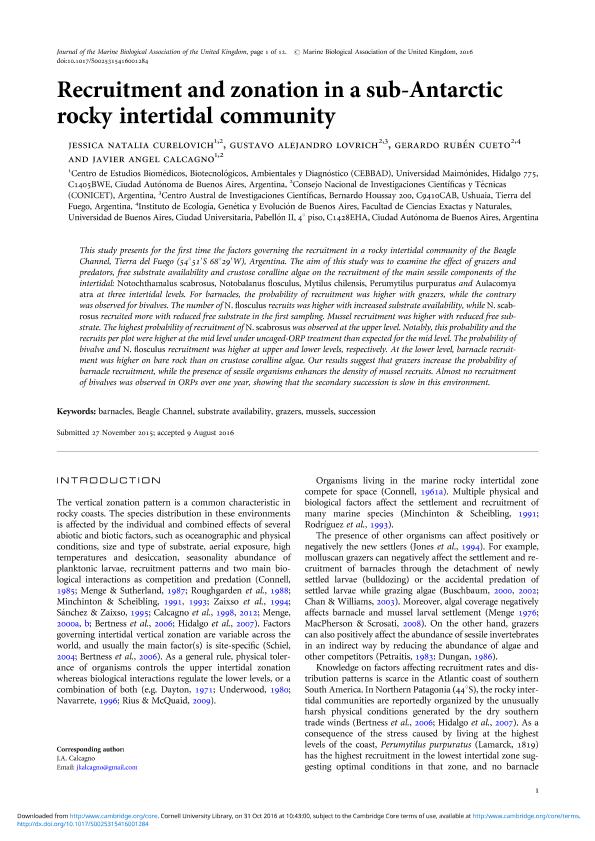Mostrar el registro sencillo del ítem
dc.contributor.author
Curelovich, Jessica Natalia

dc.contributor.author
Lovrich, Gustavo Alejandro

dc.contributor.author
Cueto, Gerardo Ruben

dc.contributor.author
Calcagno, Javier Ángel

dc.date.available
2018-03-12T22:00:56Z
dc.date.issued
2016-09
dc.identifier.citation
Curelovich, Jessica Natalia; Lovrich, Gustavo Alejandro; Cueto, Gerardo Ruben; Calcagno, Javier Ángel; Recruitment and zonation in a sub-Antarctic rocky intertidal community; Cambridge University Press; Journal of the Marine Biological Association of the United Kingdom; 98; 2; 9-2016; 1-12
dc.identifier.issn
0025-3154
dc.identifier.uri
http://hdl.handle.net/11336/38659
dc.description.abstract
This study presents for the first time the factors governing the recruitment in a rocky intertidal community of the Beagle Channel, Tierra del Fuego (54°51′S 68°29′W), Argentina. The aim of this study was to examine the effect of grazers and predators, free substrate availability and crustose coralline algae on the recruitment of the main sessile components of the intertidal: Notochthamalus scabrosus, Notobalanus flosculus, Mytilus chilensis, Perumytilus purpuratus and Aulacomya atra at three intertidal levels. For barnacles, the probability of recruitment was higher with grazers, while the contrary was observed for bivalves. The number of N. flosculus recruits was higher with increased substrate availability, while N. scabrosus recruited more with reduced free substrate in the first sampling. Mussel recruitment was higher with reduced free substrate. The highest probability of recruitment of N. scabrosus was observed at the upper level. Notably, this probability and the recruits per plot were higher at the mid level under uncaged-ORP treatment than expected for the mid level. The probability of bivalve and N. flosculus recruitment was higher at upper and lower levels, respectively. At the lower level, barnacle recruitment was higher on bare rock than on crustose coralline algae. Our results suggest that grazers increase the probability of barnacle recruitment, while the presence of sessile organisms enhances the density of mussel recruits. Almost no recruitment of bivalves was observed in ORPs over one year, showing that the secondary succession is slow in this environment.
dc.format
application/pdf
dc.language.iso
eng
dc.publisher
Cambridge University Press

dc.rights
info:eu-repo/semantics/openAccess
dc.rights.uri
https://creativecommons.org/licenses/by-nc-sa/2.5/ar/
dc.subject
Barnacles
dc.subject
Beagle Channel
dc.subject
Grazers
dc.subject
Mussels
dc.subject
Substrate Availability
dc.subject
Succession
dc.subject.classification
Otras Ciencias Biológicas

dc.subject.classification
Ciencias Biológicas

dc.subject.classification
CIENCIAS NATURALES Y EXACTAS

dc.title
Recruitment and zonation in a sub-Antarctic rocky intertidal community
dc.type
info:eu-repo/semantics/article
dc.type
info:ar-repo/semantics/artículo
dc.type
info:eu-repo/semantics/publishedVersion
dc.date.updated
2018-03-12T19:22:21Z
dc.journal.volume
98
dc.journal.number
2
dc.journal.pagination
1-12
dc.journal.pais
Reino Unido

dc.journal.ciudad
Cambridge
dc.description.fil
Fil: Curelovich, Jessica Natalia. Universidad Maimónides. Área de Investigaciones Biomédicas y Biotecnológicas. Centro de Estudios Biomédicos, Biotecnológicos, Ambientales y de Diagnóstico; Argentina. Consejo Nacional de Investigaciones Científicas y Técnicas; Argentina
dc.description.fil
Fil: Lovrich, Gustavo Alejandro. Consejo Nacional de Investigaciones Científicas y Técnicas; Argentina. Consejo Nacional de Investigaciones Científicas y Técnicas. Centro Austral de Investigaciones Científicas; Argentina
dc.description.fil
Fil: Cueto, Gerardo Ruben. Consejo Nacional de Investigaciones Científicas y Técnicas. Oficina de Coordinación Administrativa Ciudad Universitaria. Instituto de Ecología, Genética y Evolución de Buenos Aires. Universidad de Buenos Aires. Facultad de Ciencias Exactas y Naturales. Instituto de Ecología, Genética y Evolución de Buenos Aires; Argentina
dc.description.fil
Fil: Calcagno, Javier Ángel. Consejo Nacional de Investigaciones Científicas y Técnicas; Argentina. Universidad Maimónides. Área de Investigaciones Biomédicas y Biotecnológicas. Centro de Estudios Biomédicos, Biotecnológicos, Ambientales y de Diagnóstico; Argentina
dc.journal.title
Journal of the Marine Biological Association of the United Kingdom

dc.relation.alternativeid
info:eu-repo/semantics/altIdentifier/url/https://www.cambridge.org/core/journals/journal-of-the-marine-biological-association-of-the-united-kingdom/article/recruitment-and-zonation-in-a-subantarctic-rocky-intertidal-community/00EC3CE4B6ECFB4BBAC6595C4A1E82B8
dc.relation.alternativeid
info:eu-repo/semantics/altIdentifier/doi/http://dx.doi.org/10.1017/S0025315416001284
Archivos asociados
